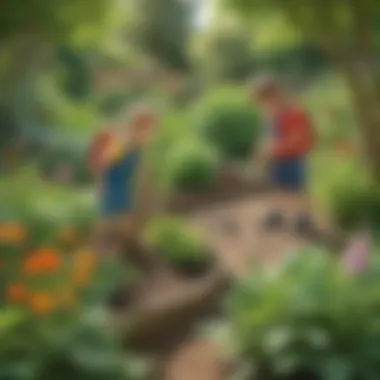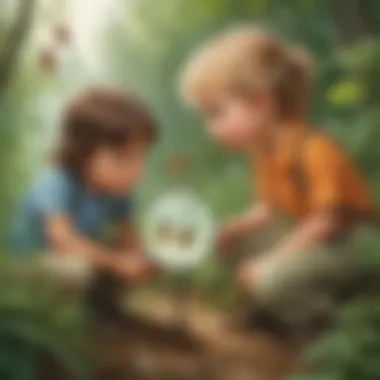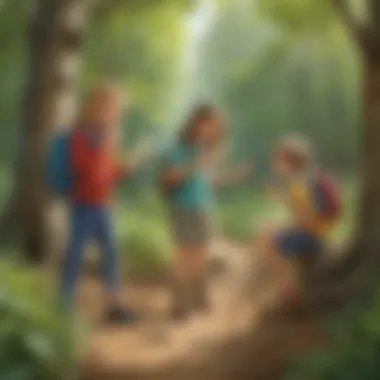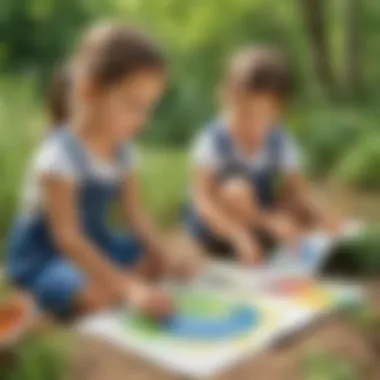Nature Activities for Preschoolers: Engaging Young Minds


Intro
Preschool is a critical period in childhood, where foundational learning occurs. Engaging with nature provides a unique platform for preschoolers to learn through experience. This article highlights a range of activities specifically designed to immerse young children in the natural world. Through exploration, they acquire new skills and develop important sensory awareness. The following sections delve into both the scientific aspects and the playful side of nature activities, aimed at parents and caregivers seeking to stimulate young minds.
Science Fun Facts
Nature is filled with intriguing and colorful facts that capture children's attention. Knowledge about the world around them can inspire a sense of wonder.
- Did you know that honey never spoils? Archaeologists have found pots of honey in ancient Egyptian tombs that are over 3000 years old and still perfectly edible.
- A group of flamingos is called a 'flamboyance.' This fun fact not only adds joy but also serves as a conversation starter.
- Caterpillars have more muscles than humans. With around 4,000 muscles compared to our 629, this fact can spark curiosity and questions.
"Exploration of nature through fun facts can ignite a young child's curiosity, leading them to ask more questions and seek answers."
Discover the Wonders of Nature
Understanding various scientific concepts can start early. By introducing preschoolers to simple ecological ideas, they can better grasp the role of living things in our environment.
- Exploring Plant Life: Encourage kids to touch, smell, and observe plants in their surroundings. Discuss parts of plants like roots, stems, and leaves.
- Educational Videos: Utilizing short, engaging videos from sources like Britannica or educational channels helps to visualize nature concepts.
- Interactive Experiences: Nature walks can be complemented with activities, like observing insects or collecting leaves.
Nature Activities to Stimulate Learning
Incorporating hands-on activities not only makes learning fun but also promotes problem-solving skills.
- Nature Scavenger Hunt: Create a list of items for kids to find in their local park or garden. Items could include various leaves, flowers, or types of rocks.
- Simple Experiments: Activities such as planting seeds can demonstrate growth cycles. Kids can note observations in a simple journal.
- Crafting with Nature: Use collected items to produce art. For instance, create leaf rubbings or paint with natural dyes made from berries.
Ending
Engaging preschoolers with nature can provide rich learning experiences. Through hands-on activities and interactive learning, children develop not only knowledge but also a deeper connection with the environment. Parents and caregivers play an essential role in facilitating these memorable experiences, helping young minds to flourish.
Importance of Nature in Early Childhood Development
The significance of nature in early childhood development cannot be overstated. Engaging preschoolers in outdoor experiences cultivates a range of essential skills and helps foster a deep connection with the natural world. When children explore nature, they are not just having fun; they are learning and growing in various ways.
Cognitive Benefits of Outdoor Exploration
Outdoor exploration is a rich source of cognitive development. Children engage their senses and stimulate their brains when they interact with elements like trees, rocks, water, and animals. Observations made during these interactions promote problem-solving skills as children figure out how things work in their environment.
Studies show that outdoor activities improve focus and attention spans. This is particularly relevant in a world filled with electronic distractions. Nature captivates preschoolers' senses and directs their attention, leading to improved cognitive functions. These experiences can provide a foundation for scientific reasoning and critical thinking as children learn to ask questions, investigate, and discover answers through hands-on activities.
Physical Development Through Nature
Nature also plays an essential role in physical development for preschoolers. Activities like climbing, running, jumping, and digging allow children to develop coordination, balance, and strength. When kids engage in these physical activities, they enhance their motor skills, which are crucial for future athletic abilities and everyday tasks.
Spending time outdoors also encourages a more active lifestyle. Physical fitness is vital for children's overall health. When preschoolers are outside, they are likely to be more physically active than when they stay indoors. This not only helps in physical development but also contributes to emotional well-being and a better quality of life.
Social Skills and Emotional Growth
The outdoor environment serves as a backdrop for social interactions among preschoolers. Engaging with peers during nature activities fosters teamwork and communication skills. Children learn to share materials, negotiate roles, and work collaboratively toward common goals. These interactions help nurture empathy and understanding of different perspectives.
Moreover, nature exposes children to emotions and experiences that can enhance emotional growth. When they climb a tree or watch a butterfly, they experience joy, excitement, or even fear. These feelings help them understand and regulate their emotions over time.
"Nature provides a stimulating platform for preschoolers to interact, learn resilience, and build a foundation for their emotional health and social competence."
In summary, engaging preschoolers with nature offers them a stimulating environment that nurtures cognitive, physical, and social-emotional development. The blend of exploration, play, and learning that occurs outdoors creates a rich landscape for growth, equipping young minds with essential skills that remain impactful throughout their lives.
Preparing for Nature Activities
Preparing for nature activities is a vital step in ensuring that preschoolers can fully engage with the outdoor experiences designed for their developmental growth. These activities, when approached with careful planning, can lead to beneficial outcomes in various domains, including cognitive skills, physical abilities, and social development. It is essential to lay a strong foundation before heading outdoors, considering elements such as location, safety, and essential supplies.
A well-prepared outing enhances not only the children's experience but also adds to the comfort and ease for parents and caregivers. Planning enables adults to provide proper supervision and reinforces the opportunity for interaction with nature in a safe manner.
Choosing the Right Location


The choice of location for nature activities can significantly influence both engagement and safety. It is important to select areas that are not only accessible but also rich in natural resources. Parks, nature reserves, and even backyards can serve as excellent settings, provided they offer a variety of natural features such as trees, flowers, or water.
When deciding on a location, consider the following:
- Safety: Ensure the area is free from hazards such as heavy traffic or wild animals.
- Diversity of Environment: Look for locations that allow for exploration of different natural elements. This can include soil, water bodies, or diverse plant life.
- Amenities: Consider proximity to restrooms and picnic areas, as these can enhance the overall experience.
A suitable site creates a rich backdrop for exploration and discovery, capturing preschoolers' curiosity and attention effectively.
Safety Considerations for Preschoolers
Safety should be a top priority when planning nature activities. Young children are naturally curious but may not have the awareness to recognize potential dangers. Thus, adults must establish guidelines that promote safe exploration. Here are key points to consider:
- Supervision: Always maintain close supervision over preschoolers. A small group is easier to watch.
- Weather Conditions: Check the forecast and dress children accordingly. Ensure they are protected from elements like sun or cold.
- Emergency Preparedness: Carry a first aid kit and know basic emergency procedures. It’s wise to have a plan in case of unexpected situations.
By being proactive about safety, adults can allow children to explore while mitigating risks effectively.
Gathering Essential Supplies
Having the right supplies can make nature activities more enjoyable and productive for preschoolers. The following items are essential to consider when preparing:
- Clothing: Dress children in comfortable and weather-appropriate attire, including sturdy shoes and hats.
- Exploration Tools: Simplistic tools such as magnifying glasses, small buckets, and notebooks can enhance their discoveries.
- Snacks and Hydration: Bring light snacks and water for breaks, ensuring children remain energized.
- Art Supplies: If engaging in craft activities, pack materials like crayons, paper, and safe scissors.
Efficiently gathering supplies can facilitate a structured and engaging experience, encouraging children to participate actively in nature.
Preparing for nature activities is not just about logistics; it's about opening doors to learning and exploration.
Sensory Nature Activities
Engaging preschoolers in sensory nature activities is essential for their overall development. These activities stimulate curiosity and enhance sensory perception, which are fundamental as children explore their surroundings. By interacting with the natural world, young learners can develop critical thinking skills and emotional awareness, laying the groundwork for lifelong learning.
Nature Scavenger Hunts
Nature scavenger hunts are an exciting way for preschoolers to explore outdoor environments. In this activity, children receive a list of items to find in nature. The list can include leaves, rocks, flowers, and even insects. This task encourages observational skills and boosts their ability to categorize and describe what they see. As children search for these items, they also learn about different elements in nature and enhance their vocabulary.
To create a scavenger hunt, parents or educators can:
- Prepare a simple list of common items found in a nearby park or garden.
- Encourage teamwork by having children pair up or work in small groups.
- Use this opportunity to teach about respect for nature, emphasizing that items should not be harmed or removed from their habitats.
Textural Exploration with Plants
Another effective sensory activity is textural exploration with plants. Providing children with various plant materials invites them to touch and feel different textures. Items can include smooth leaves from a maple tree, prickly thorns from a blackberry bush, or soft moss. This activity not only adds to sensory richness but also introduces the idea of biodiversity in an engaging manner.
To facilitate textural exploration, consider:
- Collecting a range of plant materials before the activity and presenting them in a way that is easy for kids to access.
- Encouraging children to describe how each texture feels, using words like rough, smooth, or spiky.
- Discussing where each plant grows and their role in the ecosystem, which opens the door for more extensive conversations about nature's diversity.
Listening to Nature's Sounds
Listening to sounds in nature is a calming yet insightful sensory experience. This activity helps develop auditory skills and encourages mindfulness. Children can sit quietly for a short time and intentionally focus on the sounds around them: chirping birds, rustling leaves, or a flowing stream. By recognizing these sounds, preschoolers begin to identify different elements of their environment.
To implement this activity, educators can:
- Set up a quiet space outdoors for listening, free from distractions.
- Ask children to close their eyes and make a list of all the sounds they hear.
- Later, discuss the different sounds and what animals or natural features they might be associated with.
"By engaging their senses, children build a deeper connection to nature, fostering a sense of wonder and respect for the environment."
Sensory nature activities, such as scavenger hunts, textural explorations, and listening exercises, provide varied and enriching experiences for preschoolers. Through these guided activities, children not only learn about nature but also develop essential skills that contribute to their holistic growth.
Creative Nature-Based Crafts
Engaging preschoolers in creative nature-based crafts serves multiple educational and developmental purposes. This section emphasizes the significance of using natural materials in crafting activities. Allowing children to explore their creativity within the context of nature can increase their appreciation for the environment. Also, these crafts nurture fine motor skills, promote problem-solving, and stimulate imagination. Children learn to express themselves while gaining deeper insights into their surroundings.
By using items found outdoors, such as leaves, twigs, and stones, these activities help reinforce concepts of sustainability and recycling. Moreover, engaging in creative tasks allows preschoolers to connect with their surroundings. This connection fosters a sense of responsibility towards the environment, which is crucial for developing eco-conscious individuals.


Leaf Rubbings and Impressions
Leaf rubbings are among the simplest and most enjoyable crafts for preschoolers. Thisactivity involves placing a leaf under a sheet of paper and rubbing a crayon or colored pencil over it. The natural texture and patterns of the leaf create a beautiful imprint on the paper. This craft is very beneficial for cognitive development. It helps children learn to identify different types of leaves while also enhancing their artistic skills.
Additionally, this activity promotes sensory exploration. The children feel the ridges and veins of the leaf, enhancing their tactile awareness. The process is straightforward, requiring minimal materials like leaves, paper, and crayons. When introducing it, parents or educators can encourage discussions about the colors and shapes of various leaves. This can lead to broader conversations about local flora, enhancing the educational value of the activity.
Nature Collages Using Found Objects
Creating nature collages allows preschoolers to engage in artistic expression while using found objects from their outdoor explorations. They can gather leaves, petals, stones, and more to create a collage on a sturdy piece of paper. This craft is an excellent way to discuss textures and colors. Children can explore how different items can be combined creatively.
This activity also has implications for cognitive and fine motor development. Children must grasp and arrange different objects, which enhances their hand-eye coordination. Furthermore, making a collage involves decision-making, as children choose where to place each item. They can be encouraged to describe their work, promoting language skills and expression of thoughts.
"Nature-based crafts not only foster creativity; they also strengthen the bond between children and the environment."
Creating Art from Natural Materials
Using natural materials to create art provides an innovative approach to creativity. Preschoolers can utilize various items such as pine cones, acorns, or even clay from the ground. When they shape these materials into art, they explore their inventiveness without the constraints of conventional supplies.
This type of craft can support environmental learning as children discuss where each material comes from. They learn about local ecosystems, which enhances their understanding of biodiversity. Additionally, using materials directly from nature encourages them to observe their environment closely.
By engaging in this practice, children experience the beauty of nature firsthand. Their artwork may reflect their understanding and emotional connection to the environment. It ultimately leads to a broader understanding of sustainability, inspiring them to appreciate and care for their surroundings.
Exploratory Nature Activities
Exploratory nature activities are vital for linking children to the outside world. These activities help preschoolers interact with their environment, building critical observation skills and fostering curiosity. Engaging in exploratory activities can enhance a child's understanding of nature's dynamics, promoting a sense of wonder and discovery. Furthermore, these experiences contribute to their cognitive, emotional, and physical development in a holistic manner.
Guided Nature Walks
Guided nature walks offer a structured way to explore the natural environment. During these walks, caregivers can lead children over varying terrains, highlighting flora and fauna along the way. This activity encourages kids to notice small details, like the color of leaves or the sounds of birds. Moreover, it fosters a love for nature by allowing children to ask questions as they observe. Walking together builds connection, and discussing the findings enhances their language skills.
To maximize the experience:
- Choose different routes each time to keep the walks fresh.
- Use a field guide to identify plants and animals.
- Encourage preschoolers to collect interesting items, like fallen leaves or stones, to discuss later.
Observing Insects in Their Habitat
Observing insects provides preschoolers with an engaging way to learn about ecosystems. Children can find insects in various settings, like gardens or parks. This exploration can lead to discussions about habitats, food chains, and biodiversity. Encourage kids to watch how insects move or interact with plants.
When observing insects, it's important to maintain a gentle approach. Use tools like magnifying glasses to enhance the experience. Create a simple chart of insects they observe. This activity is enjoyable yet educational, allowing children to become mini-scientists.
Bird Watching and Identification
Bird watching is another captivating exploratory activity. Preschoolers can learn to identify local birds through their colors and sounds. Setting up a bird feeder in the backyard can attract birds and provide a clear view for observation. This practice enhances attention skills and introduces children to concepts like habitats and migration.
To facilitate this:
- Use children-friendly bird guides with illustrations.
- Create a simple checklist for kids to mark off birds seen during outings.
- Discuss unique behaviors, like nesting or feeding habits.
Engaging in exploratory nature activities not only nurtures curiosity but also establishes a lifelong appreciation for the natural world.
Nature Games and Play
Engaging preschoolers in nature games and play is essential for their overall development. These activities combine learning with fun, which is crucial in maintaining a child's interest and enthusiasm for the outdoors. Nature games encourage physical activity, creativity, and social interactions. They help children understand their environment, identity, and the world around them while promoting essential skills.
Play is a powerful tool for preschoolers; it lets them explore their surroundings, express themselves, and learn how to collaborate with peers. Nature games reinforce concepts of teamwork, problem-solving, and adaptive thinking, as young children must often make choices and face challenges during play. In this section, we will look at three specific activities that blend physical movement with nature.
Nature Themed Obstacle Courses
Creating a nature-themed obstacle course is an exciting activity that aids physical development. By using natural elements like logs, rocks, and fallen branches, children can climb, jump, and crawl. It encourages gross motor skill development, balance, and coordination.
When setting up the course, consider the following elements:
- Balance beams from logs or planks for walking across.
- Hurdles made of soft, non-threatening materials for safe jumping.
- Crawl spaces using tunnels or branches for a fun hide-and-seek flavor.


This activity also stimulates imagination. Kids can pretend they are explorers or daring adventurers overcoming challenges. Moreover, they build teamwork skills by collaborating to navigate the course, sharing tips, and encouraging one another.
Nature Bingo for Visual Learning
Nature Bingo is a practical game that combines visual learning with engagement. This activity enhances observation skills as children look for various elements in their outdoor environment. Creating Bingo cards with images of plants, animals, and natural objects helps children attune themselves to their surroundings.
To set up this game, you can:
- Create unique Bingo cards with pictures of common local flora and fauna.
- Encourage collaboration by having children play in pairs or small groups. This builds social skills and fosters communication.
- Incorporate variations such as having different themes for each outing, like “flowers” or “birds.”
This game not only makes learning fun but also fosters curiosity about the world around them. It helps in reinforcing vocabulary related to nature.
Role Play in Nature
Role play in nature offers children the opportunity to enact scenarios in an outdoor setting. This type of play encourages creativity and imagination as children can take on various roles such as explorers, animals, or plants. Role-playing helps preschoolers explore different perspectives, express emotions, and make sense of their experiences.
When conducting role play, consider these ideas:
- Establish a scene relevant to nature, like a campsite or a forest.
- Provide costumes or props made from natural materials, such as leaves or stones, to foster creativity.
- Encourage open-ended scenarios where children can invent their own stories and interact without constraints.
Through role play, kids develop language skills and gain confidence in their storytelling abilities. They learn social cues and empathy by interacting and understanding various character viewpoints.
Integrating Nature into Education
Integrating nature into education transforms the learning experience for preschoolers. Engaging with the natural environment enriches children's understanding of the world. It can stimulate their curiosity and inspire exploration. Nature serves as a dynamic classroom where young minds can gather experiences which conventional settings may not provide. This approach promotes an educational framework that is holistic and child-centered.
Nature-Themed Storytelling
Nature-themed storytelling offers a unique way to connect children with their environment. It taps into a child’s innate love for stories and brings elements of nature to life. When children hear tales about animals, plants, or ecosystems, they develop a personal connection with those elements. These stories can be crafted from local folklore, animals seen during outdoor activities, or fictional characters living in the forest.
Storytelling can also incorporate facts about the environment, helping children learn in a compelling way. As children engage in storytelling, they practice listening skills and gain vocabulary. It provides an opportunity for parents and educators to add new terms related to nature into their conversations.
Engaging narratives have the power to ignite a child's imagination and broaden their perspective on the natural world.
Science Experiments in Nature
Conducting science experiments outdoors allows preschoolers to see principles of science in action. Children can observe changes in their surroundings first-hand. Simple experiments can include growing seeds, testing soil, or exploring plant life cycles. By interacting with nature, children develop critical thinking skills and learn to make observations.
For example, planting seeds in various types of soil can lead to discussions about what conditions plants need to grow. This hands-on approach makes science tangible and relevant. Moreover, it encourages questions and discussions that promote deeper learning.
Utilizing Nature for Mathematical Concepts
Using nature to teach mathematics can create an engaging learning environment. Counting leaves, measuring the height of a tree, or comparing the sizes of rocks introduces basic math skills organically. Children can also categorize objects they find, such as arranging sticks by length or sorting leaves by shape.
Moreover, outdoor explorations can introduce concepts of symmetry, patterns, and fractions in ways that are exciting and relatable. For instance, children can divide a pie made from natural materials during a picnic, allowing them to understand fractions practically. By implementing these strategies, math becomes less abstract and more applicable to everyday life.
The End: Fostering a Connection with Nature
Fostering a connection with nature is essential for preschoolers as it lays the groundwork for healthy development and a sustainable relationship with the environment. By engaging children in outdoor activities, they build vital skills and gain an appreciation for the natural world around them. This article emphasizes how such experiences are not merely recreational but foundational in cultivating curiosity and a sense of responsibility toward nature.
Long-term Benefits of Nature Engagement
Engaging preschoolers with nature offers numerous long-term benefits that extend beyond early childhood. First, regular exposure to natural settings has positive effects on mental health. Studies indicate that children who spend more time outdoors show lower levels of stress and anxiety. This can lead to improved emotional well-being as they grow.
Second, outdoor activities enhance cognitive development. Children learn to solve problems, think critically, and make connections through firsthand experience with their environment. These skills are critical for academic success later in life.
Furthermore, nature encounters help in the development of social skills. When preschoolers partake in group activities, they learn to cooperate, share, and communicate effectively with peers. This collaboration fosters a sense of community and belonging, which is crucial as children transition into more structured social settings such as school.
"Nature is the ultimate source of inspiration, providing endless opportunities for creativity and inquiry."
In addition, engaging with nature instills a sense of respect and stewardship for the environment. When children learn about ecosystems and the importance of biodiversity, they become more likely to develop environmentally conscious behaviors in adulthood.
Encouraging Lifelong Exploration
Instilling a love for nature in preschoolers also encourages a passion for lifelong exploration. When children are introduced to nature-based activities at a young age, they are likely to seek out these experiences as they grow older. This habit can lead to a variety of enriching experiences, such as hiking, bird watching, or simply spending time in parks.
To promote this ongoing connection, caregivers can model enthusiasm for outdoor activities. This can be done through family nature walks or visiting different natural landscapes. Parents and educators can also create opportunities for inquiry-based learning. Asking open-ended questions during outdoor experiences encourages children to observe and think deeply about their surroundings.
Additionally, integrating technology in a limited way can enhance exploration. For example, nature identification apps can help children recognize plants and animals, creating a blend of learning and fun. This approach allows children to engage with nature interactively while embracing modern tools.







